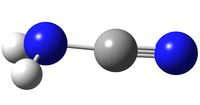|
Cyanamide tunnels between two equivalent positions,
just as ammonia does. Details of the data set
were described by
(1) A. Coutens, O. Zakharenko, F. Lewen, J. K. Jørgensen,
S. Schlemmer, and H. S. P. Müller,
2019, Astron. Astrophys., 623, Art. No. A93.
Most of the experimental data within each tunneling
state were taken from that work. Additional data
are mostly from
(2) A. Krasnicki, Z. Kisiel, W. Jabs,
B. P. Winnewisser, and M. Winnewisser,
2011, J. Mol. Spectrosc., 267, 144.
Few low frequency transitions are from
(3) R. D. Brown, P. D. Godfrey, and B. Kleibömer,
1985, J. Mol. Spectrosc., 114, 257;
and from
(4) J. K. Tyler, J. Sheridan, and C. C. Costain,
1972, J. Mol. Spectrosc., 43, 248.
Several parameters were kept fixed to parameters
from a slightly rearranged parameter set of the
main isotopolog as described in (1).
Since no c-type transitions between the two
tunneling states have been published, these
transitions cannot be predicted reliably at
present, and their predictions have been omitted.
Predictions should be viewed with caution
once the predicted uncertainties exceed
0.2 MHz.
There are ortho and para states in
cyanamide with a ratio of 3 : 1.
The ortho states are described by
Ka odd and even for the lower
and upper tunneling component, respectively.
Since cyanamide appears to be a hot core molecule,
separate consideration of ortho and para
states is not needed.
The dipole moment components were assumed to agree
with those of the main isotopolog taken from (3).
|
